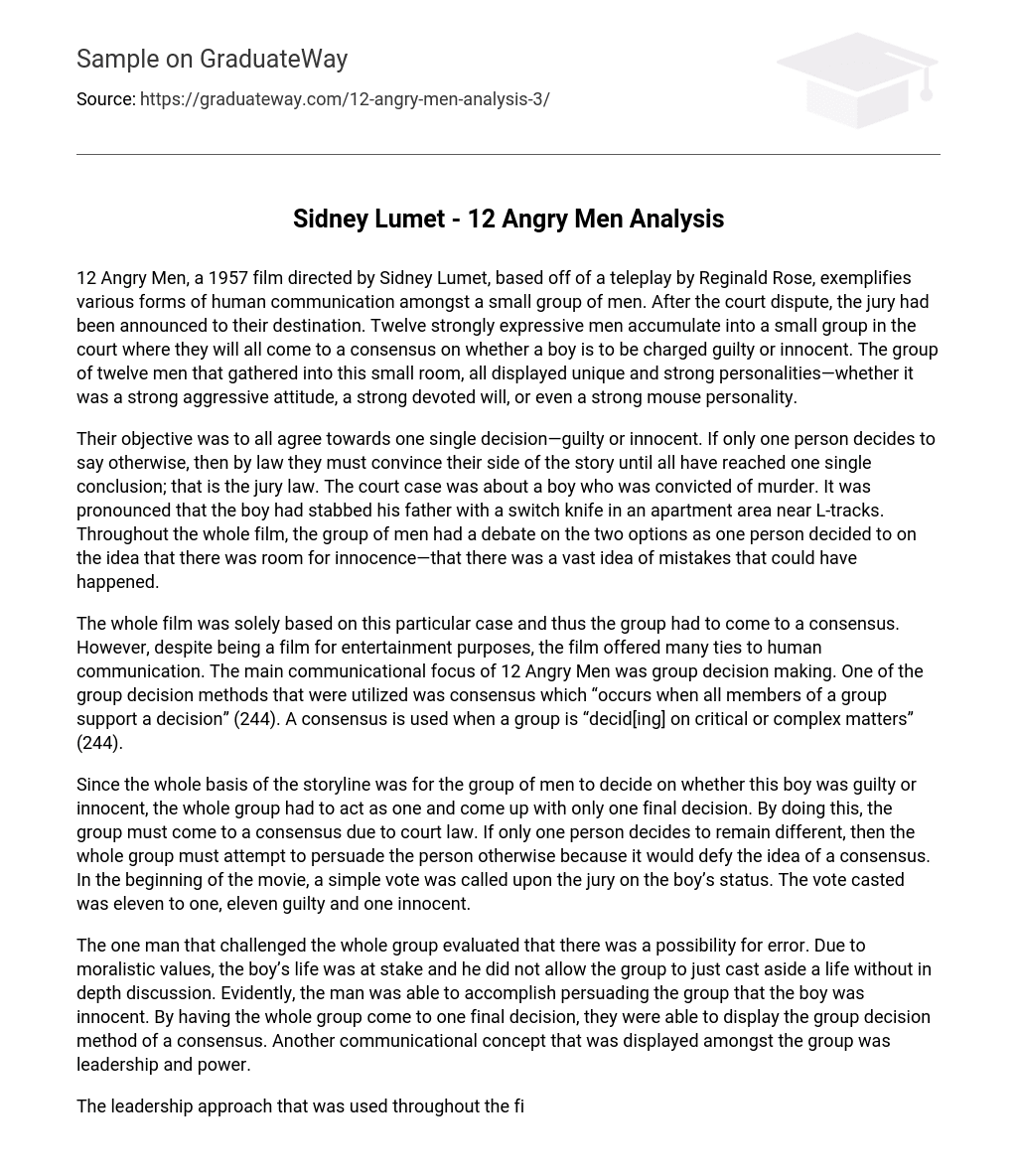12 Angry Men is a 1957 film directed by Sidney Lumet and based on a teleplay by Reginald Rose. The film showcases various forms of human communication within a small group of men. Following a court dispute, the jury is assembled in a small courtroom to collectively determine the guilt or innocence of a young boy. Despite their strong and diverse personalities, these twelve men must ultimately reach a consensus.
The main goal was for all of them to come to a unanimous decision – guilty or innocent. If even one person disagreed, they were required by law to argue their point until they all agreed on a single verdict. This is known as the jury law. The trial revolved around a young man who stood accused of murder. According to the pronouncement, the boy used a switch knife to stab his father in an apartment complex close to the L-tracks. Throughout the entire film, the group of men engaged in a heated debate between the two options. One person believed there was a possibility of innocence, suggesting that there were numerous potential mistakes that could have occurred.
The entire film centered around this specific case, requiring the group to reach a consensus. Although the film’s primary intention was to entertain, it also explored various aspects of human communication. 12 Angry Men primarily focused on group decision making in its communication. Consensus, a method of group decision making, was employed. Consensus occurs when every group member agrees on a decision (244). This decision-making approach is particularly useful for critical or complex matters (244).
The entire premise of the plot revolved around a group of men deliberating on the guilt or innocence of a particular boy. It was essential for the group to act as a unified entity and reach a unanimous verdict. This was mandated by court law, as a consensus had to be achieved. If even one person held a different opinion, the rest of the group had the responsibility to persuade that individual to reconsider, as it would go against the concept of consensus. At the beginning of the movie, the jury took a simple vote regarding the boy’s status. The results of the vote showed that eleven jurors found him guilty, while one believed him to be innocent.
The individual who challenged the entire group perceived the potential for error. Concerned about moral values, he prevented the group from disregarding a life without thorough deliberation. Ultimately, he successfully convinced the group of the boy’s innocence. This collective decision-making process demonstrated the use of consensus. Additionally, the group demonstrated the concepts of leadership and power in their communication.
The film utilized a democratic leadership style where members were encouraged to participate in decision-making (254). Each member had to present their arguments for why the boy was innocent or guilty in order to reach a consensus. There was no dominant leader influencing the group; instead, decisions were made collectively with input from all members. The distribution of power within the group was explored using different methods in the film.
The text explores the use of coercive power, which refers to the ability to impose unpleasant consequences. Despite knowing that the boy might be innocent, one man strongly believed in his innocence and feared that he would suffer undeserved consequences. This fear allowed the man to indirectly threaten the group with the consequence of death if they did not choose logically. This idea influenced the other men, as they considered the possibility of innocence.
Throughout the group discussion, reward power was employed by influencing others through the granting or promising of desirable consequences (250). In the confined space of the room where the men were debating, the urge to pursue their hidden agendas and leave became a reward. This influenced some to vote guilty in order to expedite their departure. Furthermore, information power was exercised as each individual possessed significant information that could sway the group’s decision.
The man who strongly believed in the boy’s innocence was able to challenge all evidence of guilt, providing multiple alternative scenarios and possibilities. This made many people in the group reconsider their views. Leadership and power dynamics have a significant influence on group communication. The film also highlighted the importance of structured problem solving. The group of men utilized problem consensus as a format, which ensures equal participation, especially when some members are more vocal than others (264).
The central aspect of group communication was reaching an agreement. Problem consensus ensured that every member had an equal platform to share their thoughts and opinions on the decision at hand. Given the diverse range of personalities among the twelve men, problem consensus enabled even the more reserved individuals to express themselves. This approach ensured an unbiased and open-minded influence, leading to a final conclusion that considered everyone’s perspectives.In general, the group structure plays a role in influencing other communicational concepts and can cause conflicts. On the whole, the film was enlightening as it demonstrated that mistakes are always possible. The film depicted various forms of communication related to human communication and its concepts. These different forms of communication heightened the intensity and understanding of the central situation in the storyline. Ultimately, despite being black and white, the film had vibrant aspects.





